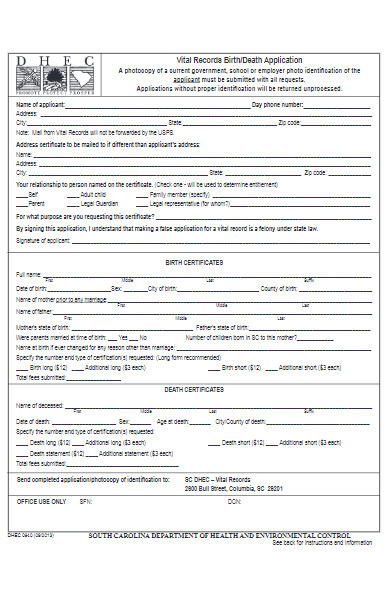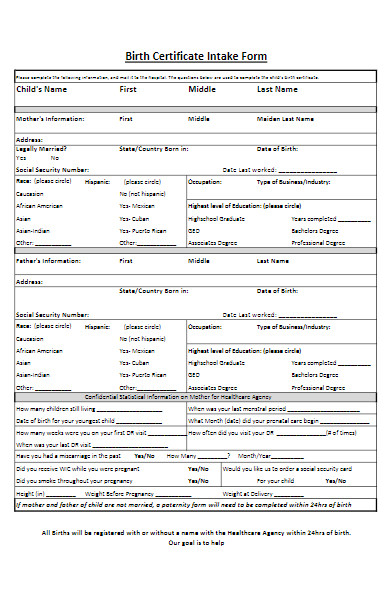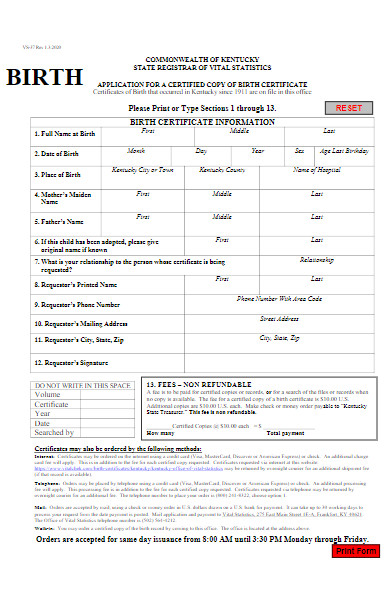The effect of the coronavirus pandemics does not only revolve around the people who are infected, recovered, and died, but also in shaping the global birth rate graphs. According to an article posted on IFStudies.org, the declaration of birth rates are likely to reduce during the epidemic. But after it has passed, the fertilities in the affected countries will rebound. Several months later, would birthing centers expect a spike on birth notification that requires them to prepare more birth forms? Let us find out below.
FREE 15+ Birth Forms in PDF
What Is a Birth Form and Why Is It Important?
Fun Fact: Based on the survey conducted by the US Census Bureau, the estimated newborn babies in a day in the US are 10,800, which is one birth every eight seconds. Legally, most children, but not all, who are born will be given birth certificates. That will keep a vital record of the child for statistics, tax, military, and census purposes. Thus, a birth certificate is one of the most common documents whose significance is undeniable.
Meanwhile, humanitarian Desmond Tutu once said, “(a birth certificate is) a small paper, but it actually establishes who you are and gives access to the rights and privileges, and the obligations of citizenship.” In most countries, especially in the United States and the United Kingdom, birth forms are crucial in identifying a person’s real age, citizenship status, and identity. Without this form, social security number, passport, school admission, driver’s license, employment, and other benefits will not be issued.
What Is a Form Document?
A form is a tool to complete an administrative process or any related transaction. It serves as part of work communication. Any job’s outcome is as good as the tools used, which means well-created forms are effective documents in collecting meaningful data.
Oftentimes, a form does three things—it starts an action, records a transaction, and reports details. Though common in the business industry, organizations like universities, hospitals, recruitment agencies, insurance companies, etc. also use forms for their transactions.
Additionally, the State of North Dakota website’s definition of a form is any document that is created to record information. It provides fillable spaces together with headings, captions, boxes, or other required details. All these are guideposts of the entry and its interpretation.
Different Types of Birth Forms and Its Definition
Usually, the details a birth form carries out are vital for citizen rights and privileges. Because of that, some countries come up with a centralized system to gather these details. Learn more about the various types of birth forms and how it is significant in documenting individuals. Here some of them:
1. Birth Certificate Request Form
This form is a document that an individual can use to retrieve a copy of their birth certificate. Usually, a person can request a copy of his or her birth certificate if it was lost by accident. Also, you can use this form to process certificates from vital statistics.
2. Notification of Birth Form
A birth registrar will send out a notification of birth to the parents once the birth of their child has been recorded. The main purpose of this form is to heads up the parents and change incorrect information in the registration. The form is also crucial for statistical purposes.
3. Birth Intake Form
A birth intake form is a document that contains relevant information about the birth of a child. This form is necessary for hospitals, municipality registrars, and other administrative offices that collect citizenship records. More so, this form requires more specific information depending on where it is used.
4. Pre-registration Birth Form
Before labor, the patient has to fill out a pre-registration form to turn over personal information about the pregnancy, and insurance or payment details. That is why it is important for hospitals and the patient who will take labor. As an expectant parent, this form will make your life more convenient because it will advance you to the delivery area.
5. Birth Certificate Application Form
A birth certificate application form is a standalone document that an individual should comply with before acquiring an official copy of the birth certificate. The completion of this document is a crucial part of the birth registration process.
6. Vital Records Birth/Death Application Form
This type of form is also used to request a death certificate or both live birth and death records. To acquire the requested document, an individual should completely fill out the required fields within the form. The vital records birth/death application can serve as a birth certificate request form too.
7. Birth Filing Form
A birth filing form is different from a birth certificate and a live-birth. However, some information in this form is needed in the birth certificate. It contains important details such as parental information, medical records, the gender of the baby, name, as well as the hospital of birth.
8. Date of Birth Form for Unified Family (Court)
This type of birth form is common for court proceedings. The information on the date of birth form for a unified family entails the legal declaration of the date of birth of the family members.
Then and Now: The Benefits of Birth Forms
Did you know that the documentation of birth or other vital statistics started as a tradition through families and their churches? Whether you believe it or not, it was a modern idea when the government stepped in to record vital information. The United Kingdom started the collection of birth information by their national government in 1853. And in 1902, the United States followed.
Apart from that, some states have been primarily collecting vital information, such as Virginia in 1632 and Massachusetts in 1639. And in 1907, the US government implemented a standard birth certificate, which is still the same birth form Americans use today.
1. Proof of Citizenship
In the height of World War II, the United States experienced a “birth certificate crisis.” The reason was the high demand for a state-certified copy of the birth certificates. During the war, Americans could not apply for any job without proof of their citizenship. That is why they need a birth certificate because it is the only way for them to be identified as Americans.
After WW II, many organizations such as schools, companies, and even some government offices highly depend on the birth certificate as documentation for several activities, rights, and privileges. Thus, the importance of registering children is understood by many parents. According to Americanbar.org, keeping a birth certificate is a way to secure your children’s rights as citizens.
2. Health and Statistic Meter
A birth form like a birth certificate has two main parts: legal portion and statistical portion. Like an affidavit form, a power-of-attorney form, and an authorization form, the legal portion of the document tells more about the person’s personal information, which includes name, date of birth, and parent’s name, among other things. This establishes the child’s legal identity.
On the other hand, the statistical portion of the birth certificate carries out the parent’s education, socio-economic data, and prenatal history. Overall, this portion of the birth certificate helps the health sector to identify regional health problems and tells about the general health of mothers and infants.
Thus, it helps the government recognize health trends like early pregnancy rate, congenital disabilities, and HIV. These data are used to propose actionable measures related to public health and prioritize funding for effective programs.
3. Legal Back-Up
A birth form is not only an effective proof of citizenship but also a legal back-up. Hence, when it comes to inheritance, eligibility, and support services, as a child, you have to present a birth form to justify the relationship between your parents.
How Do You Create Birth Forms that Work?
Often, the administrative offices that collect birth data on a national level have standard birth form formats. This is a common implementation to ensure unified documentation and verification. However, organizations that serve as the primary entry for birth data like the hospitals, birthing centers, local civil registrars, and more, have to come up with a birth form that communicates and transfers information from one entity to another. If you are to make self-declaration forms, you do not have to sweat it out because below are simple tips in creating one.
1. Start with a Draft
Starting an application form, order form, appointment form, contact form, or consent form, is a challenging task. But when you get the hang of it, it will be easier. If it seems too difficult to draft the birth form, you can refer to existing forms or old references in the library or on the internet. The draft will be the visual representation of the birth form, but it is not the final output yet. Thus, your task will be easier this way.
When you have the most suitable reference for the birth form, think about your objectives and workaround it. Remember, you should not copy your reference. Else, it will be plagiarism.
2. Incorporate Relevant Fields
As both legal and statistical documents, you should take your time in making the birth forms. Before providing the required fields, think about the parts as critically as possible. Unnecessary fields do not make a working birth form, so, you have to simplify.
If the birth form is easy-to-understand, it is also easy-to-use. Thus, it makes the birth form a reliable information-gathering tool. More so, the birth forms will record details that will be part of an individual’s lifetime. So, avoid incorrectness by making sure the form is refined.
3. Provide Instructions and Important Messages
Apart from the required fields, instructions are also important for birth forms. As a fillable form, these instructions guide the person who is filling it. Plus, you can include terms and conditions relative to the birth form. You can even compose a special message for the readers.
4. Make It Simple and Neat
The purpose of the birth form depends on who will be its audience. It is important to consider the clarity of the document because you will never know who has access to it at any time. So, make sure the birth form looks professional and neat. Also, it will clearly convey the message of the form.
Whether you are making a restaurant form, hospital form, work form, representative form, or construction form, always create the form with your readers in mind. Try to think about their response to your document. With that, you will know how to improve the birth form.
FAQs
What are the vital records?
Vital records are printable form documents under strict government authority, such as birth certificates, marriage licenses, marriage certificates, and death certificates. It may also include civil unions and domestic partnerships in some local government offices.
What is the difference between the certificate of live birth and birth certificate?
A certificate of live birth is a document that proves you are medically delivered. In contrast, a birth certificate justifies your legibility as a citizen, who your parents are, your birthplace, and the date of your birth.
Despite any crisis, the global birth rate is a relevant occurrence that people should take seriously. Whether we like it or not, we should take part in taking care of our population. We can partake by acknowledging every mother giving birth through birth forms. Forms like employment application forms, customer information forms, teacher evaluation forms, and parent feedback forms have different purposes. However, these forms work on a common ground which is keeping records of vital information.
Related Posts Here
-
Rental History Form
-
Advertising Contract Form
-
Service Agreement Form
-
Income Statement Form
-
Accident Statement Form
-
Performance Review Form
-
Event Contract Form
-
Contest Registration Form
-
Waiting List Form
-
Restaurant Schedule Form
-
Mobile Home Bill of Sale
-
Landlord Consent Form
-
60-Day Notice to Vacate Form
-
Financial Statement Form
-
Product Evaluation Form















